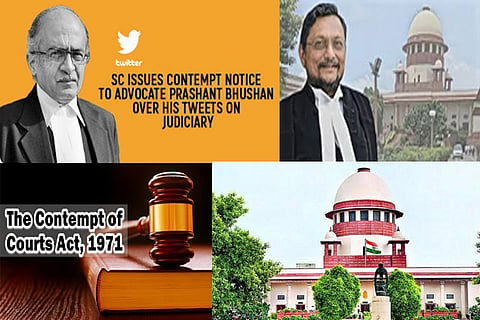

Chennai
It is both surprising and regretful that the Supreme Court failed to do this in the case of advocate Prashant Bhushan, who has been served a suo motu contempt notice for two tweets, one on Chief Justice of India SA Bobde and the other that includes former CJIs. Bhushan’s tweets were sweeping, less than tasteful and unbecoming of a senior advocate who practices in the Supreme Court. But even so, the Supreme Court would have done well to simply overlook the tweets rather than use its contempt powers, which in this case is akin to using a sledgehammer to swat a fly. Ironically, it was the same bench of the Court which said, a day later in another case, that “the voice of dissent in a democracy cannot be shut down.”
Discomfort about the judiciary’s use of criminal contempt powers is intimately linked to the legislation that empowers it to use it – The Contempt of Courts Act, 1971. The definition of what constitutes criminal contempt in the Act is distressingly vague – including, as it does, the publication (written or spoken) of any matter that “scandalises or tends to scandalise, or lowers or tends to lower the authority of, any court”. The subjectivity of such a provision makes it extremely difficult to determine what constitutes criminal contempt, since what scandalises one judge may not even bother another, and what one court regards as lowering its authority, another may not.
In short, there is no clarity on what constitutes contemptible material. While there have been many calls for scrapping The Contempt of Courts Act altogether, the very least that must be done is to do away with the “scandalising” provision. The contempt powers would then be limited to failing to obey a court order (which is generally civil and not criminal contempt) and for disrupting proceedings in a courtroom, which is an absolute requirement for the smooth administration of justice. One former Supreme Court justice maintained that the only justification for using criminal contempt powers was if someone made his functioning of a judge impossible, for example, by shouting and screaming in court, threatening a witness, or running away with a court file.
The power of criminal contempt was never meant to insulate the judiciary from criticism. There is indeed a whale of a difference between criticising a judgment and making sweeping remarks about judicial integrity. But wasn’t it the Supreme Court itself which said some years ago that its shoulders should be broad enough to withstand even distasteful criticism and that it should keep freedom of speech uppermost in mind? The world of free speech is a chaotic place, that by its very nature is prone to exaggeration, excess, and affront. The best response to those who are in the habit of making controversial statements with the intent to rattle people, is to ignore them.
Visit news.dtnext.in to explore our interactive epaper!
Download the DT Next app for more exciting features!
Click here for iOS
Click here for Android